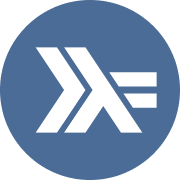Haskell Programming Homework Help - Best Online Help for Students
TutorBin is the go-to place for the best Haskell programming homework help. We understand that Haskell can be tough for students, and that's why we've made our platform user-friendly. We aim to provide a seamless and enjoyable learning experience while assisting you in achieving excellent grades. Our website is easy to navigate, ensuring you can quickly access the help you need without any ado. Our team of programmers are Haskell experts and are readily available to provide personalized support tailored to your specific requirements.
That's not all – we take pride in simplifying complex Haskell concepts, making them accessible and engaging for you. With TutorBin, you get step-by-step explanations, code examples, and real-time interaction with tutors to ensure you fully understand the subject. You can also access a wealth of study materials, including informative video solutions and a comprehensive library of solved Haskell Programming questions, enriching your Haskell learning journey.
Moreover, we offer 24/7 support, allowing you to access help whenever it's most convenient for you. Say goodbye to last-minute panic; you can rely on TutorBin for fast and efficient assistance. Whether you're struggling with functional programming, tricky type systems, or the mysteries of monads, our tutors have your back. They'll not only assist you with your homework but also ensure you grasp the core principles.
Haskell Programming Homework Help
Who Can Seek Online Help With Haskell Programming?
At TutorBin, Haskell programming homework help is readily available for a diverse range of learners looking for help with Haskell Programming homework tasks. We cater to various educational levels and purposes, ensuring that students receive the support they need to excel in this complex programming language.
1. For High School Students
High school students exploring their journey into Haskell programming encounter the complexities of functional programming and complex type systems. We recognize that these concepts can appear daunting at first glance. That's why we provide the best Haskell Programming homework help tailored to high school students. Our primary objective is to clarify Haskell's fundamental principles and provide high school students with the essential groundwork to excel in their coursework. Whether you're tackling assignments or engaging in projects, our Haskell Programming help serves as a robust foundation for this valuable subject.
2. For College Students
College students, whether at the undergraduate or graduate level, dive into the realm of Haskell Programming. Haskell's distinctive functional approach and rigorous type system can present challenges, but our comprehensive Haskell Programming help is meticulously crafted to guide you through this programming language with unwavering confidence. Whether you're delving into the complexities of monads, higher-order functions, or advanced Haskell topics, our expert tutors are here to enrich your academic journey, enhance your programming skills, and ensure your academic success both within your coursework and beyond.
Haskell Programming Tutors Online - Is It Worth To Hire Them?
When it comes to Haskell programming, hiring online tutors at TutorBin can be a wise decision in your education. On our platform, you will get access to experienced tutors who are well-versed in Haskell. Our tutors can provide personalized guidance tailored to your specific needs, making it easier to grasp the complexities of the language. They not only help you with your homework but also ensure you understand the fundamental principles behind Haskell, ensuring a strong foundation for your programming journey. Additionally, the convenience of our online homework help allows you to access assistance at your own pace and schedule, eliminating the last-minute panic associated with challenging assignments.
Our commitment to simplifying complex Haskell concepts, along with our user-friendly platform and 24/7 support, further enhances the value of our services. This ensures that you can access assistance whenever you need it, making your learning experience seamless and enjoyable. With step-by-step explanations, illustrative code examples, and real-time interaction with tutors, TutorBin is designed to provide comprehensive support. Whether you're tackling functional programming, navigating complex type systems, or unraveling the mysteries of monads, TutorBin tutors are there to guide you. So, if you're looking to excel in Haskell programming, consider hiring our online tutors to enhance your learning experience and academic performance.
Do My Haskell Programming Homework
Challenges Where Students Need Haskell Programming Assignment Help
Haskell Programming assignments present formidable challenges for students. Here are some common difficulties that students will face when working on Haskell Programming assignments:
1. Understanding Functional Programming Concepts
Haskell is a purely functional language, which means it approaches programming fundamentally differently than languages like C++ or Java. Students will struggle with concepts like immutability, higher-order functions, and lazy evaluation.
2. Syntax & Language Features
Haskell has a unique syntax and a range of powerful language features. Students can need help with pattern matching, type classes, monads, and list comprehensions.
3. Recursion
Haskell relies heavily on recursion for problem-solving. Students will face difficulty in grasping recursive thinking, significantly when solving complex problems.
4. Type System
Haskell has a solid and static type system. Understanding and utilizing types, type inference, and type classes can be challenging for students.
5. IO and Side Effects
Managing input and output in Haskell differs from traditional imperative languages. Students will need expert assistance in handling IO operations.
6. Library and Package Management
Haskell has a rich ecosystem of libraries and packages. Students will need help finding and using the right libraries for their assignments.
7. Debugging
Debugging Haskell programs can be tricky due to lazy evaluation and strong typing. Students will require help in debugging their code effectively.
Haskell Programming Topics & Concepts Covered
| TOPICS |
CONCEPTS |
| Functional Programming |
Immutability, Recursion & Monadic Programming |
| Types and Type Systems |
Algebraic Data Types, Parametric Polymorphism |
| Lists, Tuples, and Data Structures |
Records & Field Accessors, Maps & Sets |
| Pattern Matching |
Guards, Wildcard Patterns & List Comprehensions |
| Functions and Recursion |
Tail Recursion, Closures & Currying |
| Input and Output |
File I/O & Handling Exceptions |
| Error Handling |
Error Propagation and Handling |
Haskell Programming Assignment Help
What Do You Get When You Pay Someone to Do My Haskell Programming Homework?
When you decide to pay someone to do my Haskell programming homework at TutorBin, you're taking valuable assistance from our expert with your assignments. Here's what you can expect from us to receive when you hire a Haskell programming tutor:
1. Concept Clarity
Haskell programming involves complex concepts. Our programmers can simplify these concepts into easily understandable components, ensuring that you establish a strong foundation and gain confidence in applying your knowledge.
2. Guidance in Problem Solving
Haskell assignments require in-depth problem-solving skills. Our expert Haskell tutors can guide you through the process, helping you tackle complex problems, develop algorithms, and write efficient code to meet your assignment requirements.
3. Real-World Relevance
Haskell isn't just an academic exercise. Our experts can demonstrate how the concepts you're studying have real-world applications, such as in software development, data analysis, and functional programming. This helps you see the practical side of Haskell.
4. Debugging Support
Haskell programming can be challenging, especially when dealing with issues like debugging and handling errors. Our programming tutors can quickly identify and resolve coding problems, saving you time and frustration.
5. Documentation & Presentation
Effective communication is vital in programming. Our experts can assist you in creating well-structured documentation, code comments, and reports. They ensure your code is clear, precise, and properly formatted, helping you convey your ideas effectively, an essential skill in the world of programming.
TutorBin Haskell Programming Homework Help Benefits
At TutorBin, we take great pride in providing our students with a wide range of benefits when it comes to Haskell Programming homework help. Our team of Haskell programmers is dedicated to equipping you with the assistance and guidance required to succeed in your Haskell assignments. Here are some of the key advantages of opting for our Haskell Programming help services:
1. Expert Programmers
We have a team of experienced Haskell programmers who are passionate about helping students like you. Their extensive knowledge allows them to provide you with precise and optimized code explanations stepwise, along with valuable coding insights.
2. Comprehensive & Customized Solutions
Our solutions are both comprehensive and tailored to your specific needs. We don't just provide code; we also explain the logic and thinking behind it, ensuring you understand Haskell concepts thoroughly.
3. Timely Delivery
Our programmers and coders are committed to meeting your deadlines. With our quick assistance, you can submit your Haskell assignments on time, reducing the stress associated with last-minute submissions.
4. Original Work
At TutorBin, our experts take academic integrity seriously. Our solutions are authentic and free from copied content, ensuring you receive authentic and ethical help.
5. 24/7 Availability
TutorBin is here whenever you need us. Whether you have a question in the middle of the night or need assistance during the day, our expert help is available round the clock.
6. Affordable Pricing
We understand the budget constraints of students. Our pricing is competitive and designed to be affordable for students, making it accessible to everyone.
7. Flexible Scheduling
Enjoy the flexibility of setting your schedule with TutorBin. You can get help from experts online wherever you have an internet connection. It's a convenient way to learn and get the support you need for your Haskell programming assignments.
8. Direct Interaction
Our platform offers direct interaction between you and our Haskell programming tutors. This means you can discuss your assignment details, ask questions, and seek clarifications directly, ensuring a clear understanding of the solutions provided.
9. Multi-Level Expertise
Our team consists of experts with diverse levels of experience so that we can cater to both beginners and advanced Haskell programmers.
10. Revision Support
If you have any doubts or need revisions, we're here to assist. We provide unlimited revisions to ensure your satisfaction.
11. Secured account
Your privacy is our priority. We ensure that all your information and interactions with us are kept confidential.
Haskell Programming Assignment Help - Guiding You to Success with Expert Tutors
Do you need expert help with Haskell Programming homework tasks? Our team of expert programmers and coders is here to help you succeed in Haskell coursework. We understand the challenges that Haskell can pose, and our programming tutors are poised to provide prompt, real-time guidance to ensure you get top grades in your assignments.
Our Haskell programmers are here to make your learning journey smoother. They provide immediate responses and quick support to assist you in real time. Count on them to clarify doubts, provide Haskell programming examples, and simplify complex programming concepts. With their extensive knowledge, you'll receive the precise guidance needed to excel in your Haskell assignments. So, don't hesitate to reach out for our expert homework help and achieve your academic goals with ease.
Haskell Programming Homework Help Online - Available Anytime, Anywhere!
Whether you're in the USA or UK, our Haskell Programming homework help is easily accessible. At TutorBin, we provide 24/7 support for Haskell Programming, ensuring that you can get the assistance you need at your convenience, regardless of your global location or time zone. Whether you're struggling with Haskell assignments, looking for code explanations, or need help with complex concepts, our expert coders are readily available to guide you through your Haskell Programming challenges. With TutorBin, conquering Haskell assignments and mastering the language is within your reach, no matter where you are in the world.
Haskell Programming Help FAQs Searched By Students
What is the Haskell Programming language?
Haskell is a unique and powerful programming language known for its focus on pure functions, immutability, and strong typing, making it effective for complex numerical computations and functional programming. It presents a distinct approach to coding, emphasizing clarity and correctness in software development.
Which is the best website for Haskell Programming homework help?
As per student ratings, TutorBin is regarded as the best website for Haskell Programming assignment help.
Can I pay someone to do my Haskell Programming homework help?
Absolutely! At TutorBin, you can pay for our qualified tutors to handle your Haskell Programming assignments, leading to a better understanding and improved proficiency in the subject. Seeking assistance from online Haskell Programming tutors can significantly enhance your academic growth.
Can I get instant Haskell Programming homework help in the USA?
Of course, we provide instant Haskell Programming assignment help in the USA through our 24/7 online platform. Our Haskell Programming tutors are available around the clock to assist you.
What should I do if I need help with Haskell Programming?
If you're looking for help with Haskell Programming, you've landed at the right place. Just submit your Haskell Programming assignment on TutorBin, and our Haskell Programmers will provide the guidance you need.
Are there online Haskell Programming homework helpers available?
Yes, at TutorBin, you'll find online Haskell Programming homework helpers who can assist you with your coding assignments and provide valuable support.










